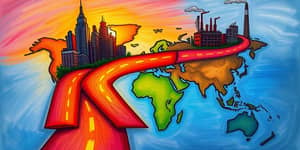
As the world's landscape transforms at an unprecedented pace, cities stand at the forefront of economic innovation, cultural exchange, and environmental responsibility. Urbanization is not just a statistic—it’s a living narrative that shapes our collective future.
Urban migration is surging. By 2050, two-thirds of the world’s population will reside in urban areas, climbing from about 4.2 billion today to 6.5 billion. This demographic wave reflects more than numbers—it represents millions pursuing opportunity, connection, and progress.
Regional shifts vary dramatically. In Africa, cities will swell from 455 million in 2018 to 1.3 billion by 2050. Asia’s urban population will grow from 2.3 billion to 3.5 billion. Coastal China is birthing an 1,800-km urban corridor, while Indian metropolises expand around seven state capitals.
Cities are engines of GDP growth, innovation, and entrepreneurship. They draw young, educated professionals and entrepreneurs, fueling new business models and cutting-edge technologies. To sustain this momentum, a robust infrastructure investment imperative must guide transport, energy, water, and sanitation projects.
Meeting demand requires billions in public and private financing. Strategic investments in smart city initiatives—such as integrated transit networks and digital logistics platforms—will determine which urban centers thrive in the coming decades.
Urban populations are diversifying rapidly. Many cities balance a growing youth cohort in Africa and Asia with aging populations in North America and Europe. This dual dynamic demands inclusive and accessible public services that range from educational access and job training to age-friendly healthcare and mobility solutions.
Increasing migration fosters cultural richness but also heightens socioeconomic stratification. Policymakers must champion social cohesion and equitable development, implementing community programs that bridge divides and uplift underserved neighborhoods.
Expanding urban footprints encroach on vital ecosystems. By 2030, nearly 6 million square kilometers of land will be urbanized, often in biodiversity hotspots across Africa and Asia. In this context, cities must lead in climate action and resource stewardship.
Green infrastructure—from parks to permeable pavements—can cool heat islands and manage floods. Energy-efficient buildings and renewable sources curtail CO₂ emissions, aligning urban growth with global climate targets.
Adopting sustainable, resilient urban ecosystems is not optional—it is essential to safeguard communities against rising climate risks.
Advances in AI, the Internet of Things, and automation are reshaping civic life. Data-driven tools optimize traffic flows, waste collection, and emergency services, while digital platforms engage citizens in real time. Successful cities weave these innovations into coherent governance frameworks that encourage collaboration across agencies and stakeholders.
A newfound emphasis on data-driven strategic decision-making processes empowers local leaders to anticipate challenges and deploy targeted interventions, ensuring that urban growth remains both dynamic and accountable.
To turn vision into reality, cities need holistic strategies. Integrating land-use planning with economic development, social welfare, and environmental stewardship creates balanced urban ecosystems ready to thrive.
Key pathways include:
When policymakers, businesses, and communities unite around a shared urban agenda, cities become epicenters of innovation, inclusion, and environmental leadership.
The future of cities rests on our collective capacity to integrate economic ambition with social responsibility and ecological balance. By embracing smart investments, inclusive policies, and cutting-edge technologies, urban centers can ignite prosperity and resilience for generations to come.
References













